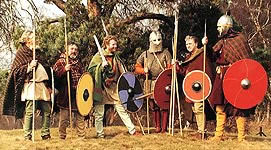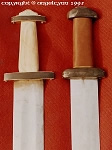 |
||||||||||||||||||||||||||||||||||||
|
Lesson #4: Page 8
Click on image for larger version in new window.
Weapons are certainly common in male burials, recent research suggesting as many as 47% of identifiable male burials contained weapons. The most common weapon is a spear, occurring in approximately 86% of all weapon burials (approximately 40% of all male burials). However, a spear is not just a weapon, it is also a tool for hunting, so a lone spearhead in a grave need not represent a warrior. If we look at graves where spears are found without other weapons we find that over 45% of those weapon burials have only spears. Graves with shields, swords or combinations of weapons are a more likely indication of warriors. Spears came in a wide variety of shapes and sizes, though certain features were common. Most had a split socket and a broad, double edged blade. Shafts were usually of ash, though other woods were also used. Some spears had a ferrule, usually of iron, on the butt end. Shields were found in about 45% of all weapon burials (about 21% of all male burials). Shields were circular and varied in size from about 0.3-0.9m in diameter, with most being around 0.5-0.6m. #2 They were made of wooden planks, alder, willow, poplar and maple being the commonest in archaeological finds (although literature usually refers to linden wood shields). They were usually quite thin, about 6-8mm, and were faced with cowhide. In the center was an iron boss covering a handle in the center. #3 The rim was bound with thick hide sewn through the wooden planks. A few shields had decorative plates or studs on the front. Swords were found in about 12% of all weapons burials (less than 6% of all male burials). The hilts were generally made from organic materials such as wood or horn. The swords of the Pagan Saxon period were usually two-edged, broad-bladed, straight-edged swords. These blades were usually of diamond or lentoid section and sometimes have one or more fullers (grooves running down the length of the blade to lighten it). During the sixth century the fullered broadsword starts to take over from the earlier spatha type. There is little evidence for the hilts of the earliest Anglo-Saxon swords, but what there is shows that the swords in use were similar to those found in the bog deposits of southern Denmark. These early forms had lower and upper guards and grips of wood, bone or horn rather than metal, and no real pommel - merely a large 'washer' over which the tang was riveted. Click on image for larger version in new window.
In the sixth century there is a new
form which seems to have been adopted by all the Germanic peoples - it
is found in Britain,
The sword was carried in a scabbard,
which was usually made of two thin laths of leather covered wood.
The mouth of the scabbard was
Large knives (seaxes), axes and arrows, other items which may be considered as weapons, were found in about 8% of all weapon burials (just under 4% of all male burials). The typical seax of the Migration period, as found on the Continent, is about 8 - 14" (20 - 35 cm) long with an asymmetrical tang. Large seaxes do not appear in England until the latter part of the Pagan period, with the earlier types generally having blades of about 6-10" (15-30cm) in length. The guard is generally insignificant, or usually non-existent, but a few of the early seaxes had decorative pommels, often boat-shaped or lobed. Two basic forms of seax were in use in England. The Germanic type has almost parallel edges, with a sharply angled back. A single narrow fuller sometimes runs down one side, or rarely both sides, of the blade, just below the back. This type is not usually seen any earlier than the seventh century. The Merovingian type has a more curved form, and often has one or more fullers on both sides of the blade. This type first appears in England during the later fifth century, reaches a peak in the sixth century, and is gradually replaced by the Germanic type in the seventh and eighth centuries. Both types have blades of triangular section. Handles were usually of horn or wood. Seaxes were carried in a leather sheath at the warrior's thigh and the sheath was usually suspended from the belt by means of a series of small bronze loops. Some seax scabbards appear to have been made of leather covered wooden laths, in a manner similar to sword scabbards. A few warriors used axes, but this was
not a particularly common weapon. It is often hard to tell
whether an axe found in a grave
Bows and arrows do seem to have been used, but to a lesser extent in England than on the continent. No bows have survived in England, although arrowheads do sometimes remain. However, on the continent many bows have been found in the Saxon homelands, and it is likely that bows in England were of the same type. These bows were wooden longbows, ranging in length from 5' - 6'6" (150 - 200cm) and were usually of Yew. The arrows were usually tipped with iron heads. Table showing the percentages of different weapons from burials by region.
1 For more detailed information see the 'Warfare' section of the Angelcynn website. back 2 Generally as you go through the period the average shield size seems to increase, with some seventh century shields reaching over 1m in diameter. back 3 Contrary to popular belief, shields did not strap to the arm, but were held with a center grip. back Page
1 | Page 2 | Page
3 | Page 4 | Page
5 | Page 6 | Page
7 | Page 8
|
||||||||||||||||||||||||||||||||||||
| Costume
Classroom is a division of The
Costume Gallery, copyright 1997-2001.
Having problems with this webpage contact: questions@costumeclassroom.com |
||||||||||||||||||||||||||||||||||||

